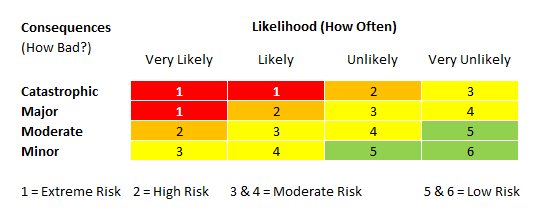Information
-
ABCo Hazardous Substance Assessment [number]
-
Manufacture's Trade Name of Substance
-
location used
-
- Brewing
- Packaging
- QA
- Inventory
- SLA Services
- Other
-
(Other) Please Specify
-
Frequency of use
- Every Hour
- Daily
- Weekly
- Monthly
- Quarterly
- Half Yearly
- Yearly
-
Risk Rateing Guide
Details of Hazardous Substance / Dangerous Good
-
Has information about the hazardous chemicals been gathered? (refer to labels, SDS, placards and<br>relevant Australian Standards for the type of hazardous chemical)
-
Name of chemical (Common Name)
-
Date of Assessment
-
Indicate persons potentially affected
- Workers
- Contractors
-
List all persons consulted
-
Description of use
-
How is the chemical to be used
-
In What quantities will the substance be ordered
-
Ordered quantities greater than 25L; Consider storing in the DG area.
-
Storage requirements
- DG Area
- Chemical Cabinate
- Cold Room
- Other
-
(Other) Please specify
-
Chemical Information (select all that apply)
- SDS Available
- SDS <5 years old
- Manufacturers or suppliers risk assessment
- Labeled to legislative requirments
- Health surveillance required
-
Please update SDS if older than 5 years
-
Type of Chemical
- Hazardous Substance
- Dangerous Good
-
Dangerous Goods Clasification
- Class 1
- Class 2
- Class 3
- Class 4
- Class 5
- Class 6
- Class 7
- Class 8
- Class 9
-
Explosives;
Explosives are materials or items which have the ability to rapidly conflagrate or detonate as a consequence of chemical reaction. -
Gases;
Gases are defined by dangerous goods regulations as substances which have a vapour pressure of 300 kPa or greater at 50°c or which are completely gaseous at 20°c at standard atmospheric pressure, and items containing these substances. The class encompasses compressed gases, liquefied gases, dissolved gases, refrigerated liquefied gases, mixtures of one or more gases with one or more vapours of substances of other classes, articles charged with a gas and aerosols. -
Flammable Liquids;
Flammable liquids are defined by dangerous goods regulations as liquids, mixtures of liquids or liquids containing solids in solution or suspension which give off a flammable vapour (have a flash point) at temperatures of not more than 60-65°C, liquids offered for transport at temperatures at or above their flash point or substances transported at elevated temperatures in a liquid state and which give off a flammable vapour at a temperature at or below the maximum transport temperature. -
Flammable Solids; Substances Liable to Spontaneous
Combustion; Substances which in Contact with Water, Emitting Flammable Gases;
Flammable solids are materials which, under conditions encountered in transport, are readily combustible or may cause or contribute to fire through friction, self-reactive substances which are liable to undergo a strongly exothermic reaction or solid desensitized explosives. Also included are substances which are liable to spontaneous heating under normal transport conditions, or to heating up in contact with air, and are consequently liable to catch fire and substances which emit flammable gases or become spontaneously flammable when in contact with water. -
Oxidizing Substances and Organic Peroxides;
Oxidizers are defined by dangerous goods regulations as substances which may cause or contribute to combustion, generally by yielding oxygen as a result of a redox chemical reaction. Organic peroxides are substances which may be considered derivatives of hydrogen peroxide where one or both hydrogen atoms of the chemical structure have been replaced by organic radicals. -
Toxic and Infectious Substances;
Toxic substances are those which are liable either to cause death or serious injury or to harm human health if swallowed, inhaled or by skin contact. Infectious substances are those which are known or can be reasonably expected to contain pathogens. Dangerous goods regulations define pathogens as microorganisms, such as bacteria, viruses, rickettsiae, parasites and fungi, or other agents which can cause disease in humans or animals. -
Radioactive Material;
Dangerous goods regulations define radioactive material as any material containing radionuclides where both the activity concentration and the total activity exceeds certain pre-defined values. A radionuclide is an atom with an unstable nucleus and which consequently is subject to radioactive decay. -
Corrosive Substances;
Corrosives are substances which by chemical action degrade or disintegrate other materials upon contact. -
Miscellaneous Dangerous Goods and Articles;
Miscellaneous dangerous goods are substances and articles which during transport present a danger or hazard not covered by other classes. This class encompasses, but is not limited to, environmentally hazardous substances, substances that are transported at elevated temperatures, miscellaneous articles and substances, genetically modified organisms and micro-organisms and (depending on the method of transport) magnetized materials and aviation regulated substances. -
First aid and emergency requirements
- First Aid Kit
- Special First Aid Requirements
- Spill Kit
- Eye Wash
- Safety Shower
- Diphoterine
- Other
-
(Special First Aid Requirements or Other) Please Specify
-
Have relevant legislation, standard, codes of practice been considered?
-
Have external sources such as manufacture's risk assessment and specification, installation and maintenance guidelines, been used to assess risk?
Risk Assessment (include photographs where relevant)
-
Nature of Hazard
- Toxic
- Harmful
- Corrosive
- Irritant
- Sensitiser (May cause allergic reaction)
- Carcinogenic
- Mutagenic
- Teratogenic (may cause birth defects)
- Other Hazard/s
- None
-
(Other Hazard/s) Please Specify
-
Possible route/s of exposure
- Eyes
- Skin
- Inhalation
- Ingestion / Swallowing
- Injection
-
Controls are inadequate if not present when SDS requires them or if not functioning well.
-
What current controls are present?
- Isolation
- Local extraction ventilation (fume huds)
- General Ventilation
- Natural Ventilaion
- Other Engineering Controls
- Safe Work Methods (eg pump instead of pouring)
- Information (at least SDS and Label)
- Ongoing Training (Hazards, Safe use, PPE)
- Personal Protective equipment
- First Aid Supplies/equipment (eg safety shower)
- First aid training
- Evacuation Plan, emergency plan and required emergency equipment
- Other Controls
-
(Other Controls) Please specify
-
Please select required PPE
- Gloves
- Eye Protection
- Face Shield
- Mask
- Respirator
- Head Protection
- Chemical Suit
- Other
-
(Other) Please specify
-
Are the current controls adequate and currently available?<br>(Does the SDS recommend it, and is it present?)
-
All "At Risk" items are to be actioned, please record actions to reduce risks in the section below.
-
Conclusion
-
Full Risk assessment to be conducted by WH&S Manager
-
Is Action required to reduce risks?
-
Specify Actions to be taken: (If NA Please clarify) Log assessment in Intelex and assign actions as approprate
-
Comments
-
Assessment carried out by
-
Final Approval by WH&S Manager required via the chemicals approval process on Intelex.

















